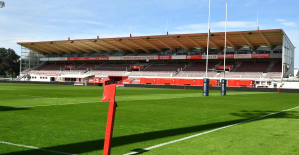The asphalt has passed and the shell craters have been filled. Fresh white anti-overtaking lines are painted early in the morning by a team of workers in orange vests.
Five weeks after the liberation of this small town in eastern Ukraine, another battle begins, with an armada of construction machinery and workers, to rebuild what remains of the infrastructure and erase the faster the scars of the Russian occupation.
And the Ukrainians are starting to use what the Russians left in their wake. Like the remains hoisted by a backhoe of a military bridge, collapsed on one of their "Z" tanks, in the Donets river.
"We will recover each of their parts, retype them and use them here or in another place where they will be needed", explains Lieutenant Denis Ponomarenko, 27, of the army's roads, bridges and roadways department.
At the entrance to the city, in the middle of the ruins, a yellow and blue welcome sign bears the message: "Friends, you are free!". It covered the Russian flag that had been stuck there from April to September.
Izioum came out of her isolation. Roads and rail links are working and the telephone and 4G network has been partially restored for about a week.
But the essential services of water, gas and electricity have been decimated, leaving the 8,000 to 9,000 people who remained or returned (out of 46,000 inhabitants before the war) entirely dependent on humanitarian aid to survive, indicates in its bulletin the United Nations Office for the Coordination of Humanitarian Affairs.
- 'What we can' -
Every day in the central square, where Ukrainian President Volodymyr Zelensky came on September 14 to hoist the yellow and blue flag again, a queue forms to hope to collect a food parcel.
"Apart from that, there is nothing that works again," plagues Ivan Zakharchenko, a 70-year-old resident who says he waits in priority for the return of the buses to go and have his pacemaker checked.
In the blue sky of Izioum, calm and without the slightest missile, a worker on a telescopic ladder nails sheets of chipboard on the gaping windows of the historic church of the city, built in 1648 at the same time as the old fortified city.
"The renewal of the church is a symbol of the renewal of the city", comments on the ground, satisfied, Semion, 48, his Orthodox priest in a cassock.
The rest of the city, entirely Soviet in its arrangement around stately public buildings now in ruins and blocks of workers' buildings, is nevertheless unlivable.
"I have some water at home, but I live on the 3rd floor and the pressure is very low. I also have electricity, but we have no gas and no heating and we don't know if we will have enough for the winter," worries a resident, Nadezhda Nesterenko, 47.
“My daughter lives above on 5th and she still has a missile stuck in her roof, and her kitchen and bathroom are open to the wind,” she adds.
"Nobody came to take it away. We didn't see anyone," accuses Ms. Nesterenko.
Questioned by AFP, the mayor of Izioum, Valeri Marchenko, indicated that the municipality "was trying to help repair the damaged apartments in order to be able to heat them this winter".
"No major work can be undertaken by spring," he nevertheless acknowledges, adding that he is working with "volunteers".
"We do what we can," he said.

 United States: divided on the question of presidential immunity, the Supreme Court offers respite to Trump
United States: divided on the question of presidential immunity, the Supreme Court offers respite to Trump Maurizio Molinari: “the Scurati affair, a European injury”
Maurizio Molinari: “the Scurati affair, a European injury” Hamas-Israel war: US begins construction of pier in Gaza
Hamas-Israel war: US begins construction of pier in Gaza Israel prepares to attack Rafah
Israel prepares to attack Rafah Spain is the country in the European Union with the most overqualified workers for their jobs
Spain is the country in the European Union with the most overqualified workers for their jobs Parvovirus alert, the “fifth disease” of children which has already caused the death of five babies in 2024
Parvovirus alert, the “fifth disease” of children which has already caused the death of five babies in 2024 Colorectal cancer: what to watch out for in those under 50
Colorectal cancer: what to watch out for in those under 50 H5N1 virus: traces detected in pasteurized milk in the United States
H5N1 virus: traces detected in pasteurized milk in the United States Private clinics announce a strike with “total suspension” of their activities, including emergencies, from June 3 to 5
Private clinics announce a strike with “total suspension” of their activities, including emergencies, from June 3 to 5 The Lagardère group wants to accentuate “synergies” with Vivendi, its new owner
The Lagardère group wants to accentuate “synergies” with Vivendi, its new owner The iconic tennis video game “Top Spin” returns after 13 years of absence
The iconic tennis video game “Top Spin” returns after 13 years of absence Three Stellantis automobile factories shut down due to supplier strike
Three Stellantis automobile factories shut down due to supplier strike A pre-Roman necropolis discovered in Italy during archaeological excavations
A pre-Roman necropolis discovered in Italy during archaeological excavations Searches in Guadeloupe for an investigation into the memorial dedicated to the history of slavery
Searches in Guadeloupe for an investigation into the memorial dedicated to the history of slavery Aya Nakamura in Olympic form a few hours before the Flames ceremony
Aya Nakamura in Olympic form a few hours before the Flames ceremony Psychiatrist Raphaël Gaillard elected to the French Academy
Psychiatrist Raphaël Gaillard elected to the French Academy Skoda Kodiaq 2024: a 'beast' plug-in hybrid SUV
Skoda Kodiaq 2024: a 'beast' plug-in hybrid SUV Tesla launches a new Model Y with 600 km of autonomy at a "more accessible price"
Tesla launches a new Model Y with 600 km of autonomy at a "more accessible price" The 10 best-selling cars in March 2024 in Spain: sales fall due to Easter
The 10 best-selling cars in March 2024 in Spain: sales fall due to Easter A private jet company buys more than 100 flying cars
A private jet company buys more than 100 flying cars This is how housing prices have changed in Spain in the last decade
This is how housing prices have changed in Spain in the last decade The home mortgage firm drops 10% in January and interest soars to 3.46%
The home mortgage firm drops 10% in January and interest soars to 3.46% The jewel of the Rocío de Nagüeles urbanization: a dream villa in Marbella
The jewel of the Rocío de Nagüeles urbanization: a dream villa in Marbella Rental prices grow by 7.3% in February: where does it go up and where does it go down?
Rental prices grow by 7.3% in February: where does it go up and where does it go down? Even on a mission for NATO, the Charles-de-Gaulle remains under French control, Lecornu responds to Mélenchon
Even on a mission for NATO, the Charles-de-Gaulle remains under French control, Lecornu responds to Mélenchon “Deadly Europe”, “economic decline”, immigration… What to remember from Emmanuel Macron’s speech at the Sorbonne
“Deadly Europe”, “economic decline”, immigration… What to remember from Emmanuel Macron’s speech at the Sorbonne Sale of Biogaran: The Republicans write to Emmanuel Macron
Sale of Biogaran: The Republicans write to Emmanuel Macron Europeans: “All those who claim that we don’t need Europe are liars”, criticizes Bayrou
Europeans: “All those who claim that we don’t need Europe are liars”, criticizes Bayrou These French cities that will boycott the World Cup in Qatar
These French cities that will boycott the World Cup in Qatar Archery: everything you need to know about the sport
Archery: everything you need to know about the sport Handball: “We collapsed”, regrets Nikola Karabatic after PSG-Barcelona
Handball: “We collapsed”, regrets Nikola Karabatic after PSG-Barcelona Tennis: smash, drop shot, slide... Nadal's best points for his return to Madrid (video)
Tennis: smash, drop shot, slide... Nadal's best points for his return to Madrid (video) Pro D2: Biarritz wins a significant success in Agen and takes another step towards maintaining
Pro D2: Biarritz wins a significant success in Agen and takes another step towards maintaining


















